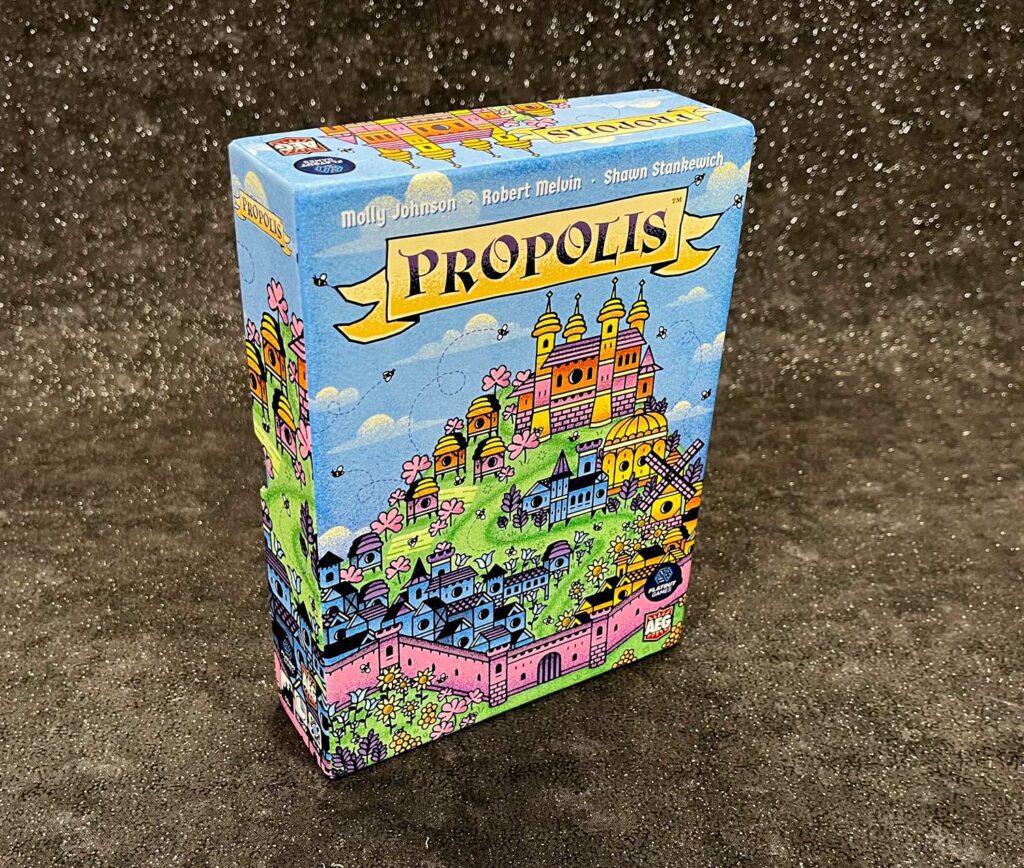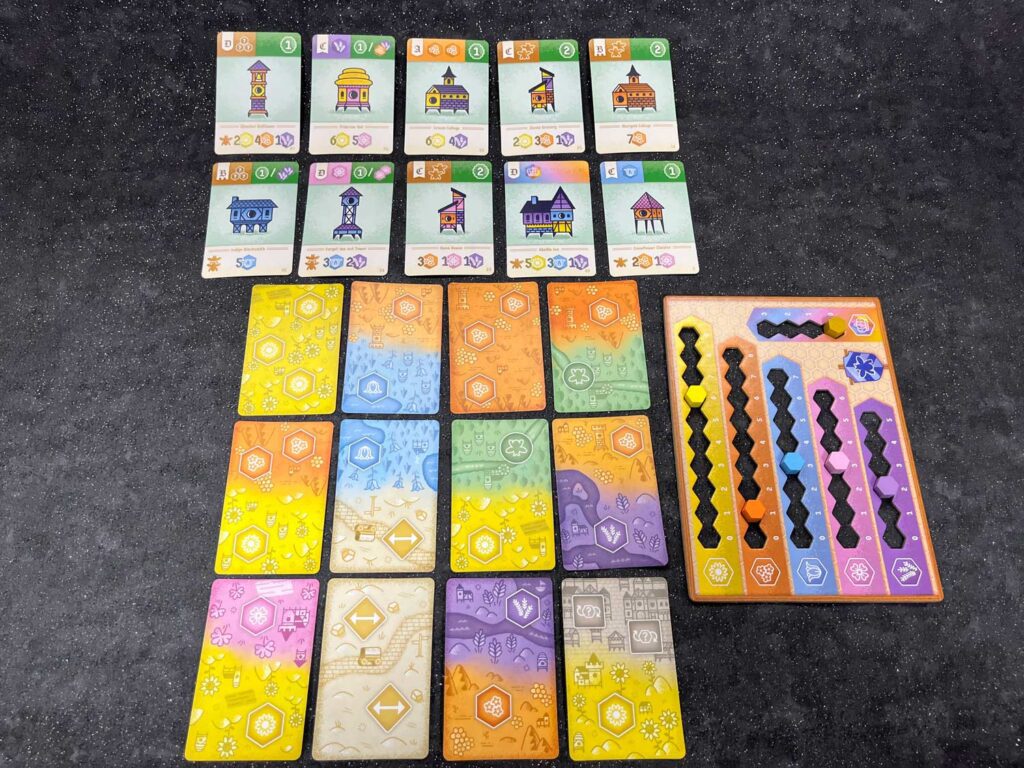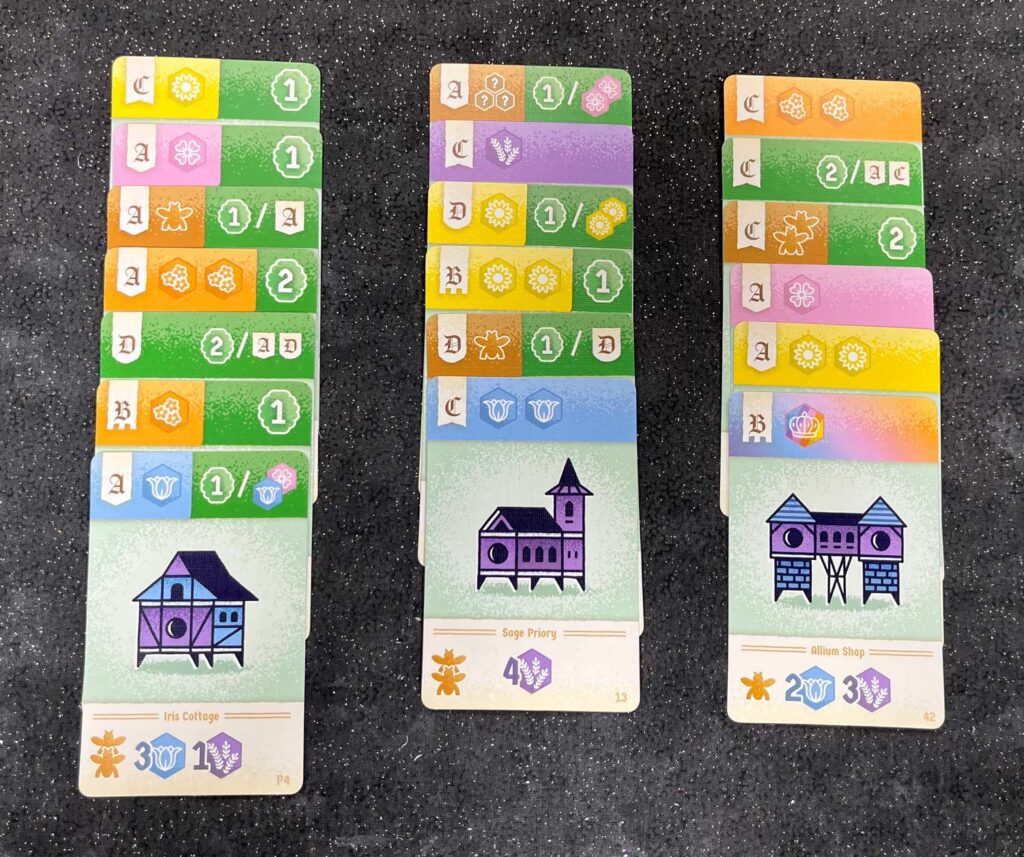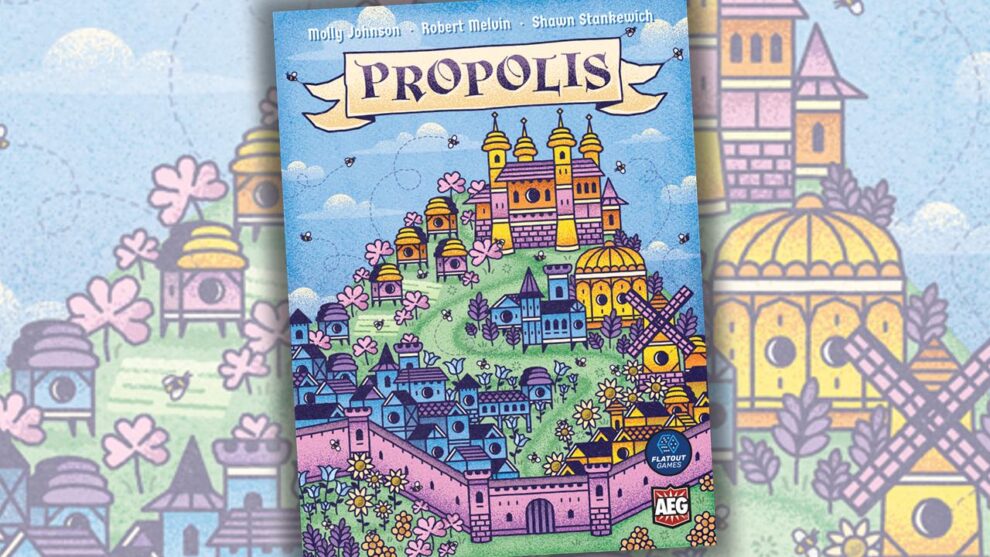Disclosure: Meeple Mountain received a free copy of this product in exchange for an honest, unbiased review. This review is not intended to be an endorsement.
You’re probably getting tired of hearing how much I adore games from the Flatout Games collective, but too bad. They’ve published some of my favorite games of recent memory: Point Salad, Calico, and of course the monster hit Cascadia. And that’s just the tip of the iceberg. So when I receive an email from Molly, Shawn, and Robert telling me they have a new game coming out, I pay attention. And when they ask if they can send me games to review I say “absolutely”.
Which is why I’ve got a copy of Propolis that I’d love to tell you about.

Propolis Overview
Unless you’re a mellitologists or apiologist, you probably have no idea what “propolis” is. It’s glue…”bee glue”. Or, to be precise, propolis is “a resinous mixture that honey bees produce by mixing saliva and beeswax with exudate gathered from tree buds, sap flows, or other botanical sources” (thanks Wikipedia). It’s basically something bees use to fill up small little gaps or cracks in their hives that aren’t already covered by the actual comb.
Or in Flatout Games case, Propolis is a worker placement game in which players send out their “beeples” (bee meeples) to gather pollen and nectar from all sorts of different flowers> They then bring it back to their hive (personal player board) in order to use those resources to build structures—yeah it’s starting to stretch the analogy a bit. Just know that Propolis is a mix of worker placement games like The River and engine building games like Splendor.
The goal of the game is to have the most points, after one player has built their tenth structure. Let’s take a quick look at the setup and gameplay.
Propolis Setup & Gameplay
Propolis comes with a few decks of cards, a bunch of wooden beeples, some player boards and resource markers. Propolis also comes with a small deck of cards for solo play, should that be your thing.
After setting up the play area for a solo play, your table would look something like this:

The Landscape cards at the bottom are worker placement spaces and allow you to collect various resources, while the cards at the top are Structure cards that you will be able to build by spending your resources. On your turn you can do the following.
Deploying Bees
Pick a single unoccupied card and send any number of beeples to the spots on that card. You can fill the card, or send only one, it’s up to you. After doing so, adjust the markers on your player board to account for the newly gathered resources. You can even earn additional worker bees this way. This action was oddly difficult to understand the first time I read the rules. You’ll never have bees from two players occupying the same card, and once a bee is on a card, no other bee can be placed there (even your own). This encourages players to cherry pick valuable spaces, or to place bees on a card that blocks another player from moving into that row.
Fortify Bees
Propolis has a clever way to make sure the play area never stagnates. As players send out their bees, eventually a row will fill up. Once that happens, the player who has the majority of bees in that row removes all their bees, one card is removed, and a new card is added. To fortify, you lay down any two of your bees currently on landscape cards. This allows you to regather the resources they’re occupying, AND it causes those bees to double in value when considering the majority.
Retreat Bees
Bring back any number of bees anywhere in the main play area. Sure, this means you’re opening up spaces for other players, but now you’ve got options!
Construct a Structure
Using your gathered resources, spend them to construct one of the ten available structures. These cards are a mix of end game scoring, immediate bonus (extra resources or more bees), and, most importantly, permanent resources. This is where the engine building comes in. And to clarify the point in the first sentence of this paragraph, when you build a structure you can use gathered resources AND permanent resources. That means the more structures you build, the greater your spending power, like some bee capitalist.
You can even build a special structure called a Queen’s Palace, which is hella expensive, and requires permanent resources and not just gathered resources.
Propolis End Game & Scoring
Once a player has built their tenth structure, the end of the game is triggered.You finish the round, making sure all players have the same number of turns.
Review all your structure cards, determine your score from available resources, remaining bees, guild banners, and remaining resources. The player with the most points is the winner!
Here’s a closeup of some of the cards. You can see the gorgeous colors and artwork, with lots of different functionality: scoring options, immediate bonuses, and permanent resources to help you afford more expensive structures.

Propolis Final Thoughts
The first time we broke out the game, I thought I could teach it raw, but that ended up being a mistake, so I decided to play a solo game first. Some of the concepts took several reads to understand, so I’m glad I took that approach. The solo game uses a smaller deck of cards to help dictate your opponent’s actions, and it worked surprisingly well since there aren’t many options.
Subsequent playthroughs went much more smoothly, and I was able to teach it from memory rather than the rulebook. Everyone jumped right in and, with just a bit of prompting, was deploying and fortifying bees left and right. By the end of the games, everyone who played this with me loved it. We all agreed that Propolis offered a great blend of gameplay and strategy.
The colors are amazing, a mix of pastels and vibrant hues which help serve to differentiate resources and beeples. And Dylan Mangini’s art is always on point, this time mixing his smooth organic lines with bits of roughness and distortion to reinforce the nature aspects of the game. One member of my game group indicated that some of the resource marker colors were a bit hard to distinguish from each other. The cards have icons on them, but the markers don’t. So keep that in mind while you’re playing. I asked Flatout Games about the possibility of silk-screening the same resource icon on the markers, and they indicated it just wasn’t in the budget. Another issue we had was that several of the beeples had fine edges which broke off during gameplay. Hopefully Flatout Games will be able to address this before manufacturing begins, or they might have some problems.

Gameplay was around 45-60 minutes, although with additional plays you could probably expect to bring the time down to 30-60. It really comes down to how you’re playing the game. If you’re aggressively collecting resources, then you might be able to scoop up some cheap structure cards. But even the “cheap” ones can be expensive. So you’ll have to monitor what other players are doing in order to both protect your future plans and attempt to block their plans.
Propolis is a great mix of light strategy, clever gameplay, and beautiful artwork and components. It’s coming to Kickstarter soon, so please make sure you take a look.
And if you’re interested in games with bees, check out our reviews of Flower Fields, Beez, Bees, the Secret Kingdom, and Honey Buzz.












